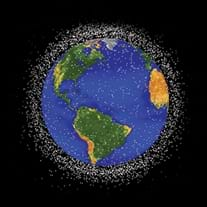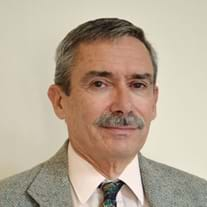Conservation on the Final Frontier
How scientists are approaching the critical need to minimize the creation of space debris, even as we expand space explorations.

Published October 1, 2018
By Robert Birchard
Academy Contributor
In 1957, the former Soviet Union launched the first satellite, Sputnik, into orbit. Not to be outdone, the United States responded with its first successful satellite, Explorer, in 1958. The Space Race was officially on.
Sixty plus years later, Earth’s orbit is no longer the exclusive realm of Cold War superpowers. Today satellites are ubiquitous, launched by operators from the public and private sectors, touching all aspects of the economy and modern life. When Sputnik first left Earth’s orbit this frontier seemed limitless, but it has become more crowded with over half a century of satellite launches.
Mostly concerned with getting satellites into orbit, few scientist and engineers bothered about what happened once they got there, until NASA scientist Donald Kessler posited what is known as the “Kessler Syndrome.” This nightmare scenario envisioned a point where the density of objects in orbit would be such that a collision would generate enough space debris to increase the likelihood of further collisions, eventually rendering Earth’s orbit unusable for any satellites.
What is Space Debris?
Space debris refers to the manmade objects that still orbit the Earth, but no longer serve any purpose. This includes anything from derelict satellites and their abandoned orbital launchers, to tools lost by astronauts on spacewalks, to specks of paint chipped off the exterior of a satellite. It is estimated that Earth’s orbit contains 21,000 objects larger than 10 centimeters (cm), 500,000 objects from 1-10 cm in diameter, and over 100 million objects smaller than one cm.

According to Juan Carlos Dolado-Pérez, PhD, Head of the Space Debris Modelling and Risk Assessment Office, the Centre National d’Etudes Spatiales (the French Space Agency), the increase in catalogued space debris followed a rather linear increase of nearly 200 objects per year from 1957-2007. Recent catastrophic events have demonstrated the resulting risk and the difficulties in navigating an increasingly crowded orbit.
The Chinese Fengyun satellite was destroyed in 2007 during an anti-satellite test adding over 3,000 catalogued debris fragments to orbit. Then a 2009 collision between the active Iridium-33 and out-of-service Cosmos-2251 satellites created over 2,000 catalogued debris fragments.
Not If, but When
“The real question is not if, but under which conditions, exponential growth of space debris will create more serious problems for space activities,” said Dolado-Pérez. “We study this question with space debris evolutionary models. Such models don’t predict the future, they allow space debris experts to study the most likely future. This is a very complicated task with many uncertainties, which need to be taken into account during calculations.”
“In many models future launch traffic is defined based on past activity, but with the emergence of the commercial space sector, aspects of these models have to be updated and take into account the uncertainty of how space will be used in the coming decades,” he says. “Moreover, the quality of debris mitigation efforts and levels of compliance will have a major impact on the size of the debris population.”
Factors Outside of Human Control
Besides variables like the increasing rate of satellite launches, there are factors outside of human control affecting space debris in orbit.
“The solar activity affects orbital drag, which can make it easier or more difficult for space debris to drop out of its orbit, and unfortunately our capability for properly predicting future solar activity is limited,” Dolado-Pérez explained. “Also the increase of gases like carbon-dioxide, (due to human activity), will have an effect on the Earth’s upper atmospheric density, which will affect the time it takes for space debris to fall out of orbit.”

Sir Isaac Newton is credited with the adage that “what goes up must come down,” but when referring to Earth’s orbit, the rate at which items can fall to Earth, varies.
“Low Earth orbit is heavily populated with satellites. Everything sent there will come down eventually,” said James Ryan, PhD, a professor in the Department of Physics and Space Science Center at the University of New Hampshire. “The other extreme is geosynchronous orbit where the orbital lifetime is practically unlimited. But mid-level orbit may be the most problematic. The orbital lifetimes there are extremely long. Junk will accumulate over hundreds of years.”
These timeframes are too long to rely on natural forces to clear Earth’s orbit. Human efforts to remove debris requires overcoming several hurdles and there is no curb-side pick-up in space.
“Manually removing debris from any orbit is awkward, inefficient, expensive and energy consuming,” Ryan explained. “One has to sidle up to the errant object, and either move it to a lower orbit, capture it or boost it to an out of the way orbit. This takes energy and is basically a one-by-one process on thousands of objects.”
“An Ounce of Prevention is Worth a Pound of Cure”
Ryan would prefer to focus on preventing the buildup of space debris in the first place.
“An ounce of prevention is worth a pound of cure,” he said. “The design of satellites must include policies and procedures for carrying out easy deorbiting. Recycling boosters like those used by SpaceX solves a lot of problems, and shows promise. Piece-by-piece removal is impractical, except for very specific circumstances, such as a large spacecraft with no means to remove itself from orbit.”

“We should not only design resilient satellites, we also need to operate them responsibly … and ensure we minimize the creation of new debris as we expand orbital operations,” said Nikolai Khlystov, Lead for the Aerospace Industry at the World Economic Forum. “The key challenge with the current regime is that current international guidelines are not enforceable.”
Khlystov suggests that a framework called the Space Sustainability Rating (SSR) could help minimize the creation of new space debris. The SSR was developed by the Global Future Council on Space Technologies, a multi-stakeholder group of international space experts and passed on to the Forum for actual development.
The SSR would provide a single, simple and transparent system to identify debris mitigation compliance in satellite design, launch and operation, thereby limiting confusion caused by overlapping and non-binding regulations put forth by various government space agencies. Private companies would benefit by “showcasing and advertising their rating without disclosing any sensitive details, as the rating would be published by a neutral third party,” he said.
More Transparency and Public Input
The SSR would provide transparency and allow the public to identify the responsible actors in the space sector.
“The fact that private actors have been entering the space sector in large numbers is a good thing. Their entrance brings innovation, new ideas, increased funding and lots of other benefits. We need to work together in a public-private partnership way to solve this particular challenge,” he added.
“Beyond SSR, one could imagine in the future a sort of consortia of public-private stakeholders — space agencies, satellite operators, launch providers, insurance companies and even investors — who come together and pool resources to solve the common problem of space debris. Of course, this kind of set-up would need careful planning and agreement,” Khlystov explained. “In principle all these actors are interested in maintaining the sustainability of orbits as they all have resources and interests that are at stake.”
Although space is infinite, Earth’s orbit is not. Its harshness belies its fragility.
“Our society is extremely reliant on space activities. Digital TV and radio broadcast, weather reporting, GPS, bank transactions and the internet all require satellites to function,” said Dolado-Pérez. “When we launch new satellites, it has to be done in a manner that keeps space sustainable. Earth’s orbit needs to be cherished because it is unique.”
Also read, The Unglamour of Space.
